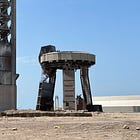I need to start this post with an IANAL.
I am not a lawyer. I deal with environmental law on an ongoing basis. But litigating cases is an entirely separate beast, and I try to be careful to separate general assessment of law and policy from the nuances of specific litigation.
Today, a consortium of non-profits and local advocacy groups sued the Federal Aviation Administration (FAA) for issuing a license to launch the Starship Super Heavy from Boca Chica, Texas. They assert that the FAA was negligent in complying with NEPA, the bedrock Environmental law governing projects sponsored by Federal Agencies. This is a view I broadly share, in case there was any question about that:
My argument when writing about “Starbase” from day one has been that the FAA and SpaceX didn’t seek to determine what the actual impacts from Starship development would be, but rather tailored the results of their studies in such a manner to demonstrate that the project would be “insignificant,” preventing years of further delays an EIS would require.
There will be plenty more on this case to come in the following weeks and months, but I wanted to hone in on a few high-level notes.
The Lawsuit was Filed in the DC Circuit
If I were handicapping the outcome of litigation against the FAA, the venue where it will be heard is an important factor. The litigants filed suit in the DC Circuit, naming The FAA and Acting FAA Administrator Billy Nolan as defendants. Because the FAA is a federal agency, its Headquarters is in the Nation’s capital; using the DC circuit as a venue is legally viable.
However, NEPA cases on individual projects, EIS, and EA decisions are primarily heard in the regional federal court circuit where projects are located. The DC circuit generally considers cases that have national significance or affect wide-reaching policy decisions by the Agency in question.
Counsel for the FAA will likely request a change in venue to Texas’ Fifth Circuit, considered one of the most conservative and industry-friendly regional federal courts.
The Plaintiffs are requesting Injunctive and Declaratory Relief against the FAA’s decision to issue a launch license.
Much of the coverage following this news centered on the 4/20 launch and mid-air explosion of the Starship rocket. However, it is clear from reading the lawsuit that a majority of the complaints center around the process of issuing a FONSI/EA and launch license based on other factors, not just the immediate aftermath of the on-pad explosion.
The plaintiffs are requesting that the court “Declare that the FAA’s PEA/FONSI/ROD for the Starship/SuperHeavy Launch Vehicle Program violate(d) NEPA and applicable regulations” and “Vacate and Remand the FAA’s decision to approve SpaceX’s application for a vehicle operator license for compliance with NEPA and applicable regulations.”
The stakes are quite high here. A legal challenge against an EIS (the larger, more comprehensive NEPA approval) that results in victory often only results in a court ruling that a specific portion of the EIS was inadequate and that the particular section be fixed.
SpaceX’s neighbors, two LNG terminals, completed separate EIS reviews via FERC in 2018 and 2019. A legal challenge was won in August of 2021, with the DC court determining that FERC’s analysis of Greenhouse Gas Emissions was inadequate. The corrective action for addressing this issue was for FERC to redo this section of the EIS. A win for the environmental groups suing but not a death blow to the projects.
SpaceX did not seek approval under a full EIS. If the court sides with the Environmental groups, the court’s likely course of action would be to require the agency to complete a full EIS. This would be a catastrophic outcome for Starship’s development, as the site would be unusable for years as a brand new EIS process is started.
In spending 2 years (starting in 2020) acquiring approval for an EA (the EIS’s little brother), SpaceX and FAA took a calculated risk that an EIS would not be required. The EIS is considered the default option under NEPA, and a court ordering this process to be initiated would not, in and of itself, be an unusual or particularly controversial judgment.
Remember that SpaceX was talking about the BFR (Big Falcon Rocket) in 2017. Plans for using the Boca Chica facility as the home for Starship started congealing in 2018.
Had SpaceX and FAA recognized at this time that a fully formed launch facility for the “largest rocket in history” would be a large use of land and meet the threshold for “significant” impact under NEPA, they could have started getting approvals. 5 years later, in 2023, a full EIS at perhaps a more appropriately sized facility could be approved and would stand on much more solid ground.
Instead, SpaceX took their mantras of “taking risks” and “constant iteration” to the regulatory sphere. They pushed the envelope on what would be acceptable under the existing 2015 approval for Falcon9 launches from a small facility well beyond a reasonable threshold and had to be forced to seek approvals after the site and launch activities had ballooned into something different.
Please subscribe if you haven’t already. I’m putting a bulk of my (non-SpaceX) content behind a paywall going forward. Your support allows me to spend more time and energy on writing stuff about capitalism, regulation, policy and ESG (the good and the bad).
And why not upgrade your plan if you’re still freeloading?
In 2020, The FAA Stated in Writing that an EIS was appropriate for the site before deferring that decision to SpaceX.
One fact I had missed until this lawsuit showed up on my radar was that in 2020 the FAA Chief of Staff for Commercial Space stated in an email that an EIS would be initiated for the site. This makes sense, as the construction of a spaceport is definitionally (and under the FAA’s own criteria) a “Project generally requiring an EIS.”
The lawsuit claims that “FAA subsequently deferred [the NEPA analysis] to SpaceX.” This characterization certainly aligns with my observations that FAA let SpaceX run the show, serving primarily as a rubber stamp for dodgy analysis that goal-seeked a desirable outcome (less NEPA review and disclosure) instead of objectively analyzing actual environmental impacts.
Plaintiffs spend a lot of time focusing on “inadequate” mitigations.
I won’t outline every single example, but a core argument in the lawsuit follows this logic:
The FAA issued a Finding of No Significant Impact (FONSI)
The FONSI includes mitigations, which means the impacts would be significant without the mitigations
The mitigations themselves are nonsensical, accomplish nothing, or are not being adhered to
The first two points above are undeniably true. Examples of the third (eg the legal argument up for debate) are interesting. As an example, the lawsuit states:
Other measures are meaningless as a practical matter, such as a requirement to turn off lighting that adversely affects wildlife when the lighting is not needed, since the PEA makes clear that such lighting will likely be required nearly 24/7
What this statement is getting at, following the logic above, is this:
SpaceX and FAA state that facility lighting will affect wildlife. For example, lights can interfere with the Kemp's ridley sea turtle’s ability to find a suitable place to lay eggs.
This is an impact that requires mitigation, so SpaceX will limit the usage of lights to only when necessary as the “Mitigation” under the FONSI.
SpaceX has had facility lights on nearly 24/7/365 and states elsewhere in the document that it is up to their discretion when they are “needed” for operational purposes.
Therefore the proposed mitigation does not accomplish what it should
I bring up this example because numerous NEPA and Endangered Species Act documents found in the Kennedy Space Center consider the lighting in an incredibly detailed manner. They all point back to this Kennedy Space Center technical document, last updated in 2022. The document has five pages dedicated to lighting practices, including defining what lights can be run and when, where they must be located, auditing procedures, and a definition of what a “necessary” use of lights at all night hours means.
This is in stark contrast to SpaceX’s approach at Starbase, which is essentially “trust us to, like, figure it out.”
The lawsuit is easy to read, so I suggest you take a look at some other examples given that discuss the adequacy of proposed mitigations.
More to come
I’ve seen this lawsuit predictably dismissed as “treehuggers ruining human progress” by internet commentators. This is predictable, especially given the rather fervent fanbase SpaceX and Elon Musk have cultivated.
I wouldn’t worry about any of that. This isn’t a PR lawsuit; there’s some real meat here. That being said, I wouldn’t rule out SpaceX and FAA coming out on top especially considering courts place a ton of trust in individual federal agencies to act in the public’s interest. Whether this is merited is certainly up for debate, but Federal agencies do generally enter these types of litigations with an inherent, built-in advantage.
Stay tuned for more.
- Eric




